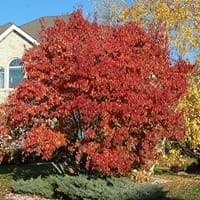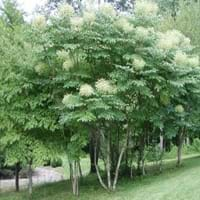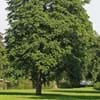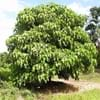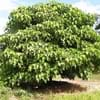Life Span
Perennial
Perennial
Origin
Eastern Europe, Western Asia
Mid-Atlantic United States, Southeastern United States, South-Central United States, Texas
Types
Not available
Not Available
Habitat
disturbed sites, Forest edges, gardens, Open Forest, Roadsides, Swamps, Urban areas
Dappled Shade, Shady Edge, Woodland Garden Secondary
USDA Hardiness Zone
3-7
4-9
Sunset Zone
1a, 1b, 2a, 2b, 3a, 3b, 4, 5, 6, 7, 8, 9, 14
3a, 3b, 4, 5, 6, 7, 8, 9, 14, 15, 16, 17, 18, 19, 20, 21, 22, 23, 24
Habit
Oval or Rounded
Thicket/Colonizing
Flower Color
Light Green, Ivory
White, Green, Ivory
Flower Color Modifier
Bicolor
Bicolor
Fruit Color
Red, Crimson
Purple, Black
Leaf Color in Spring
Green
Green, Blue Green, Dark Green
Leaf Color in Summer
Green
Green, Blue Green, Dark Green
Leaf Color in Fall
Yellow, Red, Orange, Gold, Crimson
Yellow, Green, Purple, Blue Green, Dark Green, Yellow green
Leaf Color in Winter
Not Available
Not Available
Leaf Shape
Lobed
bipinnate
Plant Season
Spring, Summer, Fall
Spring, Summer, Fall, Winter
Sunlight
Full Sun, Partial Sun
Full Sun, Partial Sun
Type of Soil
Loam
Clay, Loam, Sand
The pH of Soil
Acidic, Neutral, Alkaline
Acidic, Neutral, Alkaline
Soil Drainage
Well drained
Well drained
Bloom Time
Early Spring, Spring
Summer
Tolerances
Drought, Pollution, Salt, Shade areas, Soil Compaction
Pollution, Soil Compaction
Where to Plant?
Ground
Ground
How to Plant?
Layering, Leaf Cutting, Seedlings, Stem Cutting
Cuttings, Divison, Seedlings
Plant Maintenance
Low
Medium
Watering Requirements
Keep ground moist, Medium, Requires consistently moist soil
Needs high amount of water
In Summer
Lots of watering
Lots of watering
In Spring
Moderate
Moderate
In Winter
Keep Slightly Dry
Average Water
Soil pH
Acidic, Neutral, Alkaline
Acidic, Neutral, Alkaline
Soil Type
Loam
Clay, Loam, Sand
Soil Drainage Capacity
Well drained
Well drained
Sun Exposure
Full Sun, Partial Sun
Full Sun, Partial Sun
Pruning
Pruning in early stages, Remove damaged leaves, Remove dead branches, Remove dead leaves
Remove damaged leaves, Remove dead branches, Remove dead leaves
Fertilizers
All-Purpose Liquid Fertilizer, Bonsai
All-Purpose Liquid Fertilizer
Pests and Diseases
Aphids, Borers, Honey fungus, Red blotch, Soft scales
Aphids, Leaf spot, Mealybugs
Plant Tolerance
Drought, Pollution, Salt, Shade areas, Soil Compaction
Drought
Flower Petal Number
Not Available
Single
Foliage Texture
Medium
Coarse
Foliage Sheen
Glossy
Matte
Attracts
Deers, Not Available, Rabbits, Squirrels
Bees, Butterflies, Insects, Not Available
Allergy
Not Available
Skin irritation
Aesthetic Uses
Beautification, Cottage Garden, Showy Purposes
Borders, Woodland margins
Beauty Benefits
Not Available
Not Available
Environmental Uses
Agroforestry, Wildlife, Windbreak
Air purification
Medicinal Uses
Astringent
Alterative, Analgesic, Diaphoretic, Opthalmic
Part of Plant Used
Fruits, Leaves
Bark, Leaves, Root
Other Uses
As a tea substitute, Florist trade and landscaping, Food for animals, Showy Purposes
Used as a potherb
Used As Indoor Plant
No
No
Used As Outdoor Plant
Yes
Yes
Garden Design
Feature Plant, Foundation, Hedges, Mixed Border, Screening / Wind Break, Street Trees
Feature Plant, Foundation, Mixed Border
Botanical Name
Acer ginnala
ARALIA spinosa
Common Name
Amur Maple
American Angelica Tree, Devil's Walking Stick, Hercules' Club
In Hindi
अमुर मेपल
Devil's Walking Stick
In German
Amur-Ahorn
Teufelsspazierstock
In French
érable de l'Amour
Walking bâton du diable
In Spanish
arce de Amur
Bastón del Diablo
In Greek
Amur Maple
Περπάτημα Stick διαβόλου
In Portuguese
de bordo amur
Vara andando de diabo
In Polish
klon amur
Diabelski laska
In Latin
amur acernis
Virgam diaboli
Phylum
Magnoliophyta
Magnoliophyta
Class
Magnoliopsida
Magnoliopsida
Family
Aceraceae
Araliaceae
Clade
Angiosperms, Eudicots, Rosids
Angiosperms, Asterids, Eudicots
Tribe
Not Available
Not Available
Subfamily
Hippocastanoideae
Aralioideae
Number of Species
Not Available
Importance of Amur Maple and Devil's Walking Stick
Want to have the most appropriate plant for your garden? You might want to know the importance of Amur Maple and Devil's Walking Stick. Basically, these two plants vary in many aspects. Compare Amur Maple and Devil's Walking Stick as they differ in many characteristics such as their life, care, benefits, facts, etc. Every gardener must at least have the slightest clue about the plants he wants to plant in his garden. Compare their benefits, which differ in many ways like facts and uses. The medicinal use of Amur Maple is Astringent whereas of Devil's Walking Stick is Alterative, Analgesic, Diaphoretic and Opthalmic. Amur Maple has beauty benefits as follows: Not Available while Devil's Walking Stick has beauty benefits as follows: Not Available.
Compare Facts of Amur Maple vs Devil's Walking Stick
How to choose the best garden plant for your garden depending upon its facts? Here garden plant comparison will help you to solve this query. Compare the facts of Amur Maple vs Devil's Walking Stick and know which one to choose. As garden plants have benefits and other uses, allergy is also a major drawback of plants for some people. Allergic reactions of Amur Maple are Not Available whereas of Devil's Walking Stick have Skin irritation respectively. Having a fruit bearing plant in your garden can be a plus point of your garden. Amur Maple has showy fruits and Devil's Walking Stick has showy fruits. Also Amur Maple is not flowering and Devil's Walking Stick is not flowering . You can compare Amur Maple and Devil's Walking Stick facts and facts of other plants too.
